
Lexus’ NX nameplate is now in its second generation but the 450h+ is both the first plug in hybrid electric vehicle (PHEV) for the model line and also the Toyota Motor group luxury brand and remains so, despite the launch of a redesigned next size up RX line. We have previously sampled the, in Toyota-speak, ‘self charging hybrid’ NX 350h variant; this plug in is badged NX 450h+ – the plus symbol being the maker’s way of denoting a PHEV.
The NX 450h+ uses the same powertrain as the Toyota RAV4 Prime/RAV4 PHEVs combining an I4 2,487 cc petrol engine, good for 136kW power and 227Nm torque, with a 136kW and 270Nm front electric motor plus another one developing 40kW and 121Nm powering the rear axle and taking total power to 227kW. The non plug in hybrid NX 350h has the same ICE with identical power and torque plus the same back axle motor. The one up front is slightly different at 134kW and torque is 227Nm. Clearly Lexus enjoys some economy of scale producing hybrids with or without charging cord.
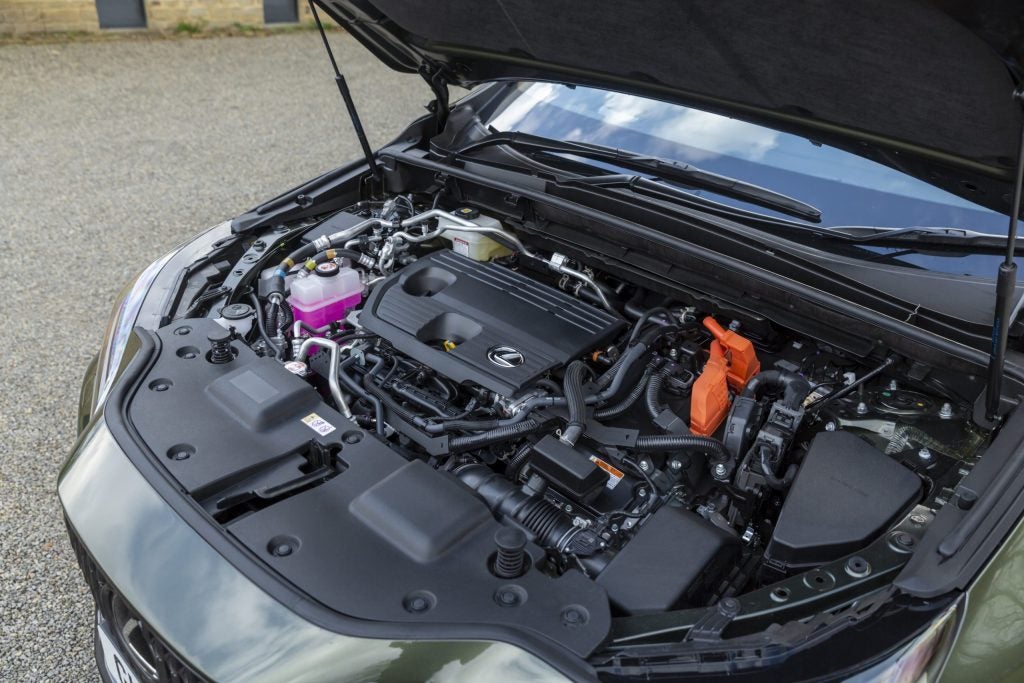
The original NX, introduced in 2014, soon became Lexus’ best selling model in Europe with well north of 175,000 units sold, most to customers new to the brand. When this second generation was introduced in mid-2021, the outgoing NX was accounting for around a third of the brand’s European sales and had also become a core model worldwide with cumulative sales then already above 1m units. In the UK it has been Lexus’s best-selling model since 2015. The smaller UX, in hybrid and all electric forms, has since been launched, the aforementioned RX flagship was fully redesigned for 2023 and the new RZ BEV-only range launched, allowing Lexus to offer European markets four SUVs in three sizes with multiple powertrain options.
The sample NX 450h+ was a top Takumi version (ie fully loaded) with Hybrid Automatic E-Four transmission and a standard size sunroof (aka moonroof in the US) for GBP62,050 on the road. Buyers who prefer the same spec with a full length panoramic sunroof – that’d be me – pay the same for that variant. Various metallic paint options add up to GBP1,020 on top – does it really cost Lexus that much more to apply the fancier coatings?
An e-latch electronic door release system replaces the internal door handle with a push-button switch positioned next to the arm rest in the door panel (this initially bemused several first time riders used to pulling a conventional lever); on the outside, a small button is located on the inside of the fixed handle. The e-latch system incorporates safe exit assist, to prevent doors being opened into the path of vehicles approaching from the rear.
Like so many new models, the NX runs through a routine to welcome you. On approach with a key fob to hand, door handles, puddle lights and daytime running lights illuminate and as the door is opened, the instrument panel lights up. Close the door, and the SUV’s side silhouette appears in the multi-information display, and when the brake pedal is pressed, the power button pulsates. Switching on begins a start-up animation with graphics and sound.

US Tariffs are shifting - will you react or anticipate?
Don’t let policy changes catch you off guard. Stay proactive with real-time data and expert analysis.
By GlobalDataThis car had a long-running Lexus feature I recall from the original 1990 LS400 V8 sedan – what I call ‘lard butt easy access’. For easy entrance and exit, the driver’s seat slides back a few centimetres and the steering column rises. Settle in and the seat and wheel return to the driver’s preferred position. At the end of a drive, switching off the power moves things back to exit position. It’s an oldie but a goodie and much appreciated when, like me, you also have stiffening hips and knees; the car is so much easier to access.
As with most brands, familiarity brings contentment and many of the SUV’s controls operated pretty much as anyone familiar with Lexus (me since 1990’s LS400) would expect. But there is evolvement, enhancement and improvement everywhere you look such as that electric door unlatching and closing and approach lights which illuminate handles, plus customisable interior ambient lighting which, thanks to cheapening LED strips, I suspect, is now found in new cars across all price points. This latest NX also (hurrah) has banished older Lexus models’ personal computer mimicking ‘mouse’ and touchpad controls in favour of a now very intuitive (and huge) central touchscreen behind which lurks software allowing an amazing amount of customisation of the SUV’s many features. Lexus says the number of switches has been reduced from 78 to 45 and they have been grouped in defined zones according to their function.
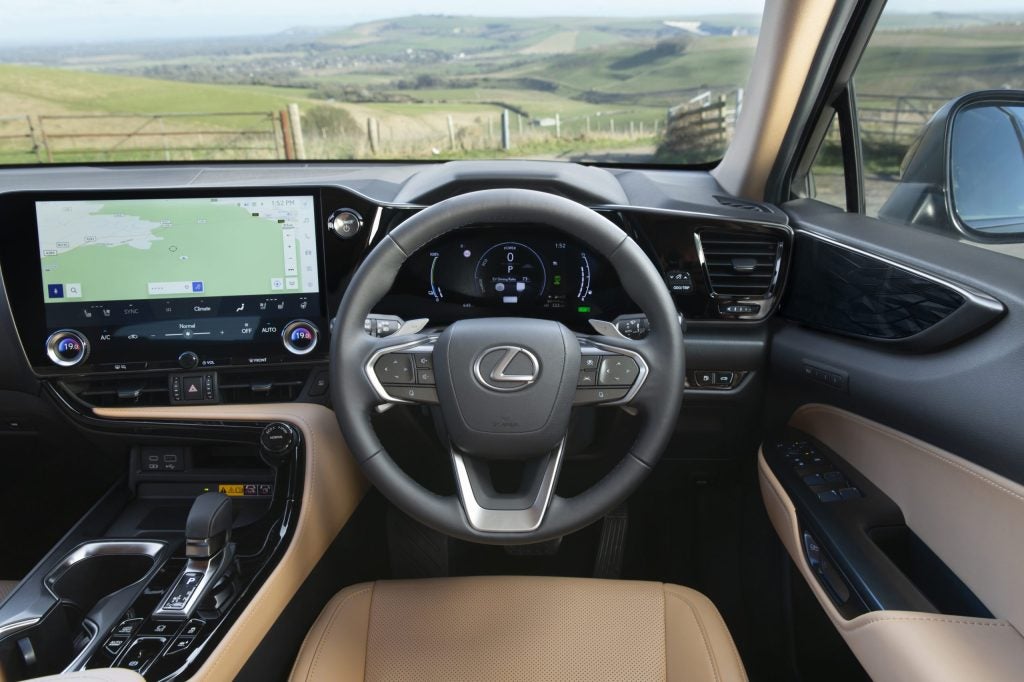
However, there are now tricky-to-use, unlabelled, touch sensitive ‘buttons’ on the steering wheel (Lexus calls them ‘touch tracers’) which activate a ‘what each button is for’ display in the large head-up display, the theory, I guess, being you can keep eyes focused better on the road ahead. These can be customised to operate the driver’s preferred functions, such as air conditioning controls or the panoramic view monitor external camera system. If the head-up display is switched off, the operation guide is shown in the multi-information display. Although they work by touch sensitivity, they have the ‘click’ feel of physical controls. Their level of touch sensitivity can be adjusted to suit driver preference. The system works well enough but is less intuitive and more confusing than I’d like. With conventional fixed function buttons you soon learn what each one is for and can find each by feel, keeping eyes-ahead.
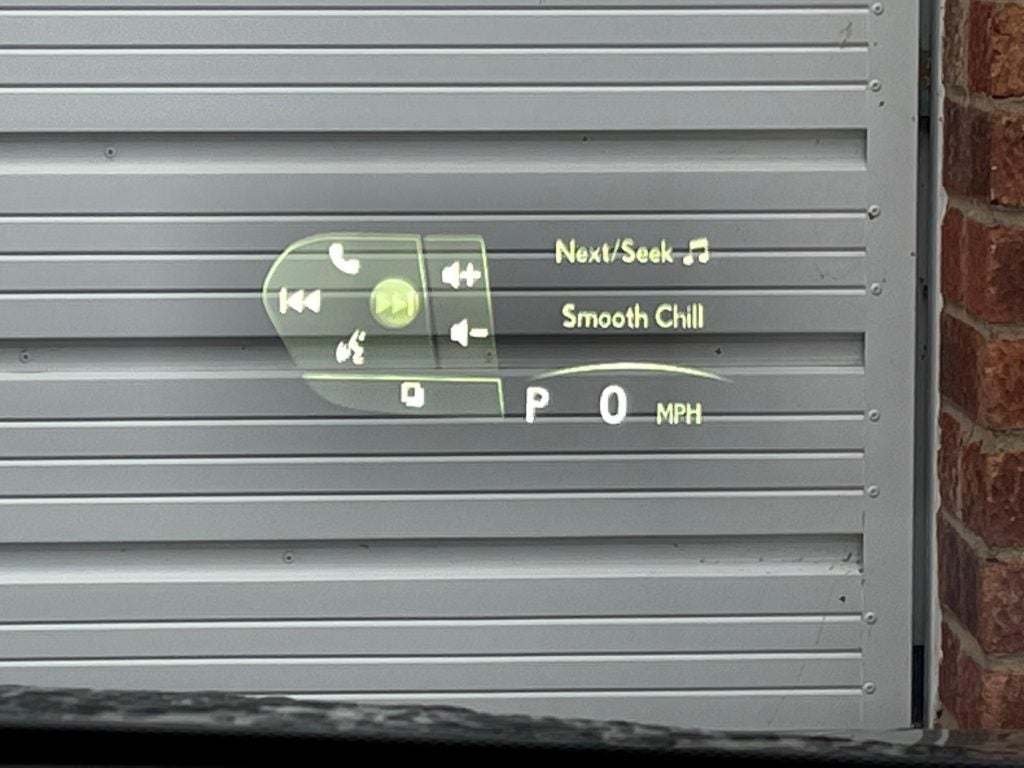
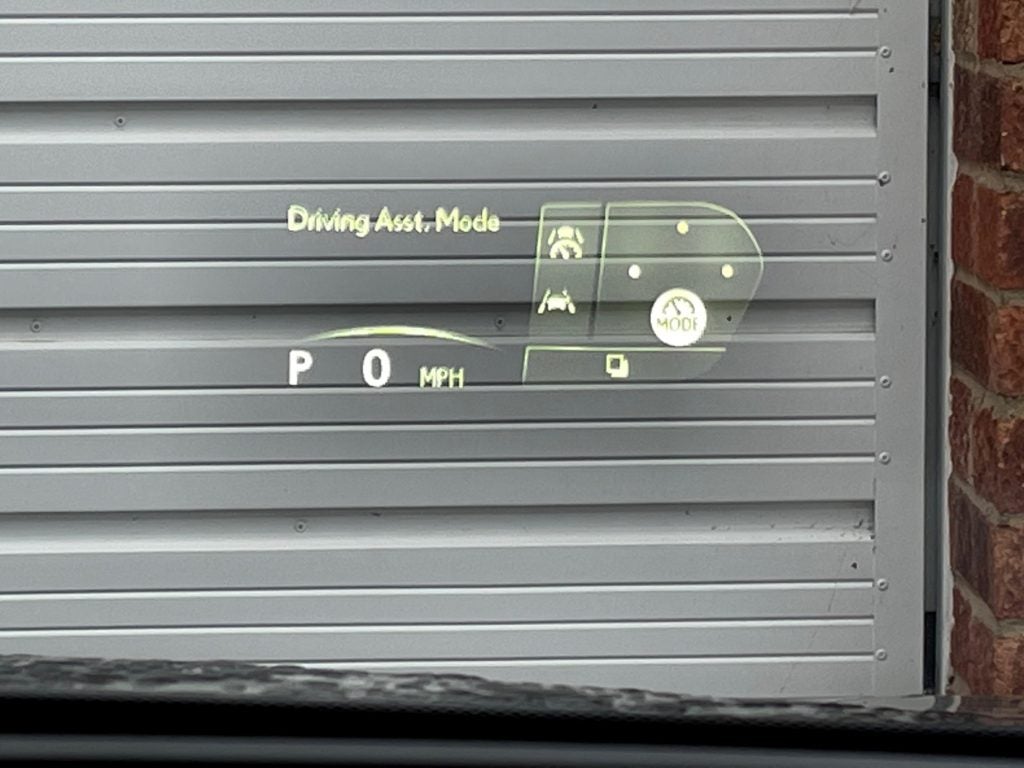
Like most more sophisticated (and expensive) PHEVs, the NX responds to a prod of the Power button with a Ready light and departs its park space in EV mode, rarely starting the ICE engine unless it’s freezing cold and items like seat, steering wheel, rear window and door mirror heaters and HVAC are all drawing a lot of current. Otherwise, it’s clearly been programmed to use the petrol engine as little as possible until the 40 miles or so of battery range is exhausted but, even then, the ICE charges the battery and the SUV reverts to hybrid mode as much as possible. For me, it combines the best of both worlds – run on plug in charged electricity around town almost all the time, yet set sail on a long trip free of range anxiety and the need to find working, unoccupied EV charge points, grapple with charging apps (too few will take any touch debit or debit card) and pay considerably more for the lecky than you do charging up at home. That, by the way, took about five hours from ’empty’ and cost, as far as my smart meter would let me figure, around GBP3.

As with all PHEVs, performance is brisk as the instant off the line torque only electric motors can deliver can be boosted as necessary by the ICE, four wheel drive gives additional launch and cornering grip, and under floor mounted battery packs lower centre of gravity for stable handling and a firmish but comfortable ride. This yet another family-oriented D-SUV that is fun to drive swiftly without upsetting its occupants.
Lexus quotes zero to 62mph (100km/h) in 6.3 seconds and a top speed of 124mph. On the official EU combined test cycle, 256.8mpg – 313.8mpg is promised.
When the redesigned NX was launched, chief engineer Takeaki Kato said: “The new NX is designed to meet the diverse lifestyles of customers around the world with a complete renewal of its key strengths, including electrification, design, driving performance and advanced technologies to broaden its appeal.”
This included Lexus Driving Signature described as “a focused and intuitive driver’s cockpit designed with the new Tazuna architecture concept and the application of advanced, human-centred technologies for safety and convenience.” In a major change to Lexus’ approach to new vehicle development, digital modelling and computer techniques were applied “for smarter engineering that can achieve a higher level of quality assurance”. There was also a focus on early adoption of new technology for safety and comfort.
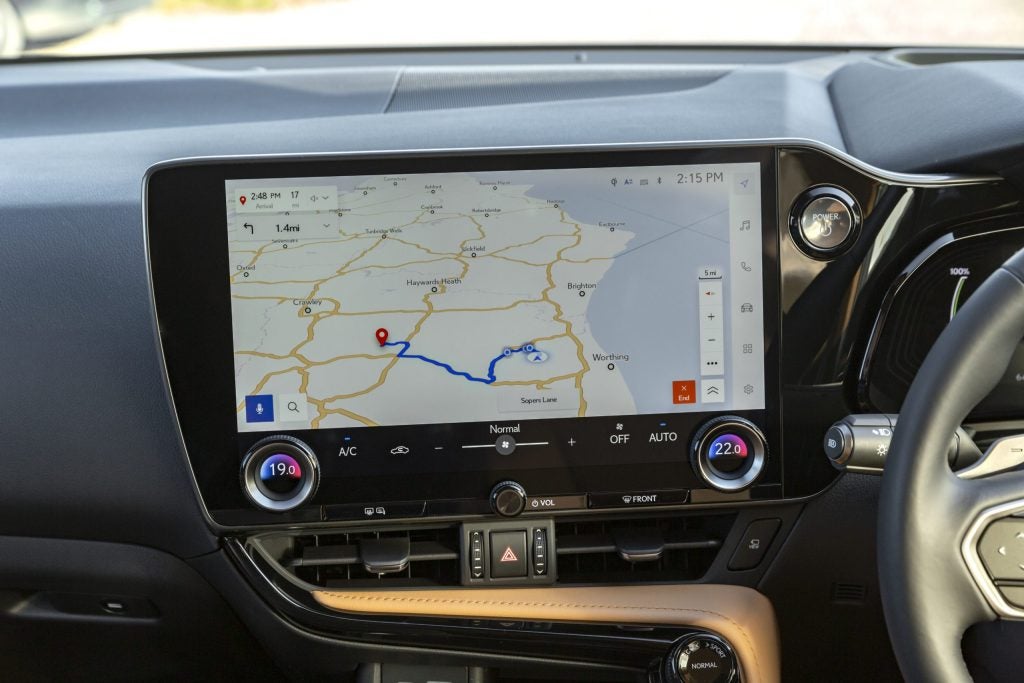
Compared to the previous generation NX, overall length rose 20mm, wheelbase 30mm, width 20mm and height by 5mm. The GA-K platform allowed for wider front (+35mm) and rear tracks (+55mm) plus larger diameter wheels and tyres (18 to 20-inch rims and 720-740mm diameter tyres).
High-grade models like this Takumi are fitted with four projector LED headlights, with the brand’s first slim adaptive high beam system (AHS). Each unit contains 11 LED chips with light output controlled by a forward camera. Like other systems of this type in previous press demos, it worked a treat in a mix of British winter urban and country road conditions, light always aimed where the driver needs it without bothering other traffic. L-shaped daytime running lights are positioned above the headlights and have seamless surface illumination with a fade-out function when turn indicators are used. Lexus joined the trend to rear lighting which spans the width of the vehicle with the UX and carried it over to the NX with new L-shaped all-LED light clusters each side.
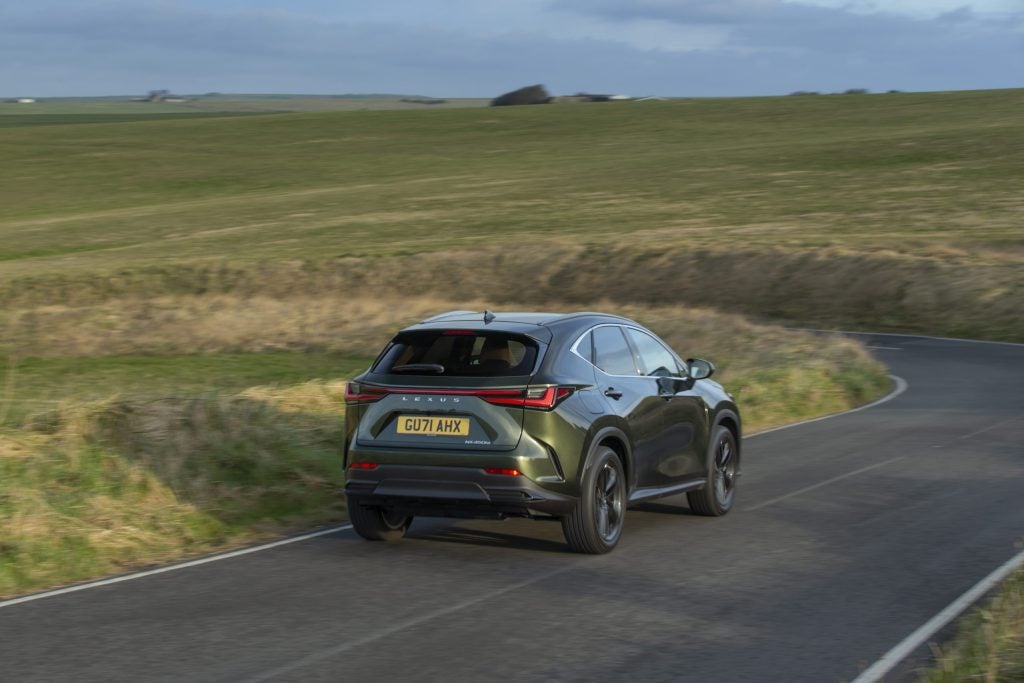
Almost every automaker offers customisable cockpits in their range nowadays and the NX is no exception with its head up display which can be used in three modes to show different levels of information: full mode includes the status of the Lexus Safety System+ safety and driver assistance features; standard mode summarises key information at the lower edge of the display; and minimum mode shows only the speed. It can be adjusted for position, rotation and brightness, with the details saved on models with driver-personalised memory settings for seat, steering wheel and mirror position (they also dip for reversing, a useful supplement to all round exterior cameras). The meters on high grade NXs (Premium Plus Pack, F Sport and this Takumi) are high definition and appearance can be customised with a choice of three layouts.
Front seats adjust electrically eight ways, and multiple drivers’ preferences can be stored for instant recall when the car recognises one of the separate key fobs used for keyless entry and start. Front seats are heated and cooled, rears are heated and there are HVAC vents back there, USB power outlets are fitted front and rear and a wireless phone charger pad in the centre console glides back to provide a small hidden storage compartment.
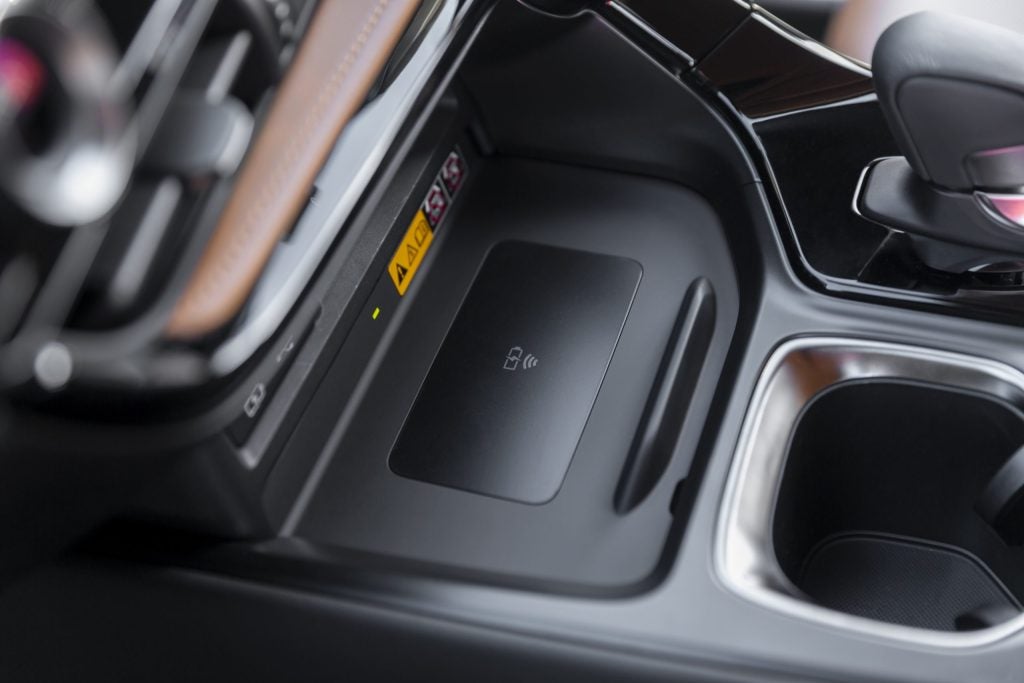
Despite an underfloor battery, load space is large, assymetric split fold rear seatbacks provide passenger/stuff carrying flexibility, a large underfloor bin stores charging cables and the electrically opening tailgate can be operated hands-free by ‘kicking’ a foot to activate a sensor under the rear bumper. That takes a little familarity as the ‘gate doesn’t close until you have stepped a little away from the SUV.
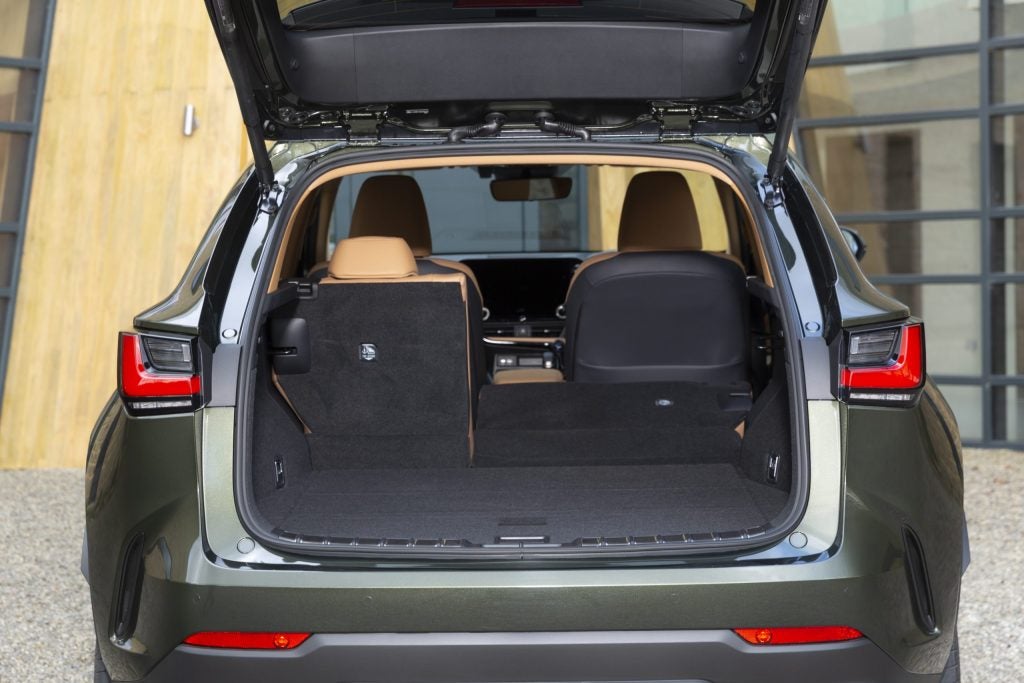
Overall, this PHEV is is a welcome addition to the NX model line and Lexus brand. It offers plenty of family sized accommodation, great performance and driving characteristics, loads of technology and a reduction in emissions and fuel consumption with its ability to travel around 40 miles on electricity alone, a boon in urban areas where vehicle pollution is most concentrated.



